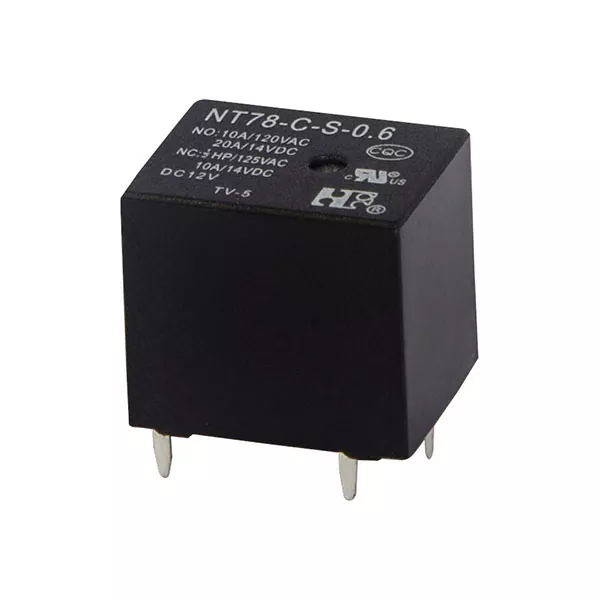Here’s a Comprehensive Overview of Automotive Relays
2024-08-02
An automotive relay is an electrically operated switch used in vehicles to control high-current electrical circuits with a low-current control signal. Relays play a crucial role in automotive electrical systems by enabling components to operate safely and efficiently. Here’s a comprehensive overview of automotive relays:
Key Features
1. Functionality
- Electromagnetic Switching: Uses an electromagnetic coil to control the opening and closing of an internal switch. When the coil is energized by a low-current control signal, it activates the relay to switch a high-current circuit.
- Isolation: Provides electrical isolation between the control circuit and the high-current load, protecting sensitive components from high voltage and current.
2. Types of Relays
- Single Pole Single Throw (SPST): A basic relay with one switch that opens or closes a single circuit.
- Single Pole Double Throw (SPDT): Has one switch with two positions, allowing it to connect one input to either of two outputs.
- Double Pole Single Throw (DPST): Controls two separate circuits simultaneously with one switch.
- Double Pole Double Throw (DPDT): Controls two circuits with two switch positions, allowing for more complex switching configurations.
3. Construction
- Coil: The electromagnetic component that generates a magnetic field when energized, actuating the switch.
- Contacts: The switch mechanism that opens or closes to control the high-current circuit. Contacts are rated for specific voltage and current levels.
- Housing: Protects the internal components and ensures proper functioning in automotive environments.
4. Specifications
- Voltage Rating: The maximum voltage the relay can handle in its high-current circuit.
- Current Rating: The maximum current the relay can carry without damage.
- Coil Voltage: The voltage required to energize the relay coil, typically matching the vehicle’s electrical system (e.g., 12V or 24V).
Advantages
1. Efficient Control
- Low-Current Operation: Allows low-current switches or control signals to manage high-current loads, reducing the need for heavy-duty switches.
- Improved Reliability: Reduces wear and tear on control switches and wiring by handling high currents through the relay.
2. Safety and Protection
- Electrical Isolation: Provides isolation between the control circuit and high-current components, protecting sensitive electronics from high voltage.
- Prevent Overloading: Helps prevent overloads on control circuits by managing high-current loads through the relay contacts.
3. Flexibility
- Versatile Applications: Can be used in various automotive applications, including lighting, starter systems, cooling fans, and more.
- Control Multiple Devices: Allows one relay to control multiple devices or circuits, depending on its configuration.
Disadvantages
1. Potential Failure Modes
- Mechanical Wear: Relay contacts can wear out over time due to mechanical movement and arcing.
- Coil Failure: The relay coil can fail, preventing the relay from operating correctly.
2. Size and Space
- Physical Size: Relays can be bulky, which may be a consideration in compact or constrained spaces within vehicles.
3. Current Draw
- Coil Power Consumption: Relays require a small amount of current to energize the coil, which can impact overall power consumption in some cases.
Applications
1. Lighting
- Headlights: Controls the power to the headlights, allowing for high-current operation without overloading the switch.
- Fog Lights: Manages fog light circuits to ensure proper operation.
2. Starter Systems
- Starter Relay: Controls the high-current circuit needed to engage the starter motor, ensuring reliable engine starts.
3. Cooling Systems
- Cooling Fan Relay: Regulates the operation of the cooling fans, ensuring that they activate at the appropriate temperature.
4. Power Accessories
- Power Windows and Seats: Manages the power supply to accessories such as power windows and adjustable seats.
Considerations
1. Relay Ratings
- Ensure Compatibility: Choose relays with appropriate voltage and current ratings for the specific application to ensure proper and reliable operation.
2. Installation
- Proper Wiring: Follow correct wiring practices to prevent electrical issues and ensure the relay functions as intended.
- Secure Mounting: Ensure the relay is securely mounted to prevent vibration or movement that could affect its operation.
3. Maintenance
- Regular Inspection: Periodically check relays for signs of wear or malfunction, especially in high-use applications.
Summary
Automotive relays are essential components that facilitate the control of high-current circuits using low-current signals. They provide safety, efficiency, and versatility in managing various electrical systems within vehicles. By selecting the appropriate relay type and ensuring proper installation and maintenance, users can enhance the reliability and performance of their automotive electrical systems.



